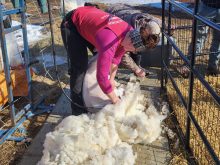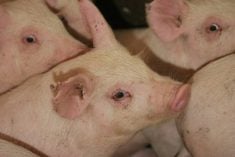A study that suggests animal productivity triples when hog manure is applied to grazing land has stunned researchers at the University of Manitoba.
“It wasn’t a surprise that the manure would increase productivity, but to see threefold increase in productivity was absolutely amazing to me,” said Don Flaten, a soil science professor at the U of M.
When Flaten and the other scientists compared a pasture treated with 110 pounds of manure per acre to a control pasture with no manure, the results showed that cattle gained triple the weight on the fertilized plot.
Read Also

Charges laid after cattle theft
Saskatchewan RCMP lay two charges against a man after six cattle went missing.
On average, cattle gained 302 lb. per acre on the manure treated field, compared to 89 lb. per acre on the control plot. The results were based on 89 days of grazing.
Flaten noted the performance was outstanding, given that the experiment was done on marginal soils in eastern Manitoba.
“These soils are so incredibly nutrient deficient, that their response … is just incredible,” he said.
The study, which began in 2004, was conducted on a 100 acre field near La Broquerie, 60 kilometres southeast of Winnipeg. The research into pig manure sprang out of the hog industry boom in Manitoba. The province had two million head in 1980 but now has approximately nine million pigs.
Producers in southeastern Manitoba, which has the highest concentration of hog barns in the province, routinely spread manure on their pastures. But the benefits and risks of this practice are not fully understood, hence the need for the study.
In addition to the weight gain, and likely explaining it, the researchers determined hog manure increased the protein concentrations of pasture grass by 80 percent, compared to the control plots.
The U of M team also studied treated and untreated hay fields. The results indicated a three-fold increase in forage yield on the fields treated with manure, based on the amount of biomass generated.
Investigating a potential risk, a summary of the study said there was no evidence that significant quantities of nitrate moved into the ground water.
“Water is dynamic at this site. It can rise to the surface and drop down in the summer,” said Mario Tenuta, soil science professor at the U of M. “The nutrients, from all indications of the results, are held up and tied up in the plants, particularly in the roots … so I was tremendously surprised by the power of the plants to act as a sponge (and retain) those nutrients.”
Several academic papers are expected to come out of this study, which will continue at the site near La Broquerie.
“We at the university level feel very strongly that this kind of work needs to be published, so that policy development in our province can be based on sound science,” said Kim Ominski, assistant professor of animal science at the U of M.
In recent months, professors at the U of M agriculture department have been vocal critics of the province’s NDP government.
The NDP’s moratorium on new hog barns in certain regions of Manitoba has been the primary focus of their derision. Shortly after the moratorium was announced in early March, the dean of the faculty, Michael Trevan, told the Winnipeg Free Press that the policy was poorly conceived and made without regard for scientific fact.

















